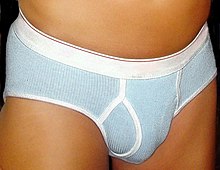Briefs


- For other uses of Brief(s), see Brief
Briefs are a type of short, tight Y-shaped underwear and swimwear, as opposed to styles where the material extends down the legs.
In the case of men's underwear, briefs, unlike boxer shorts, hold the wearer's genitals in a relatively fixed position, which makes briefs a popular underwear choice for men who are participating in athletic activities or who feel they need more support than loose-fitting underwear can provide. In addition, boxers often ride up the body when the wearer is running.
Tight briefs have been blamed for negatively affecting the sperm count, as they may interfere with the cooling of the testes.[1] However, research doesn't always come to the same conclusion. A study in the October 1998 Journal of Urology, for example, concluded that underwear type is unlikely to have a significant effect on male fertility[2]. There is a reduction in living sperm due to heat, but healthy sperm output is not affected.
History
Briefs were first sold on 19 January 1935 by Coopers, Inc., in Chicago, Illinois. They dubbed the new undergarment the "Jockey" because it offered a similar degree of support as the jockstrap (one style of which is also called Jock brief or Support briefs). Thirty-thousand pairs were sold within three months of their introduction. In North America, "Jockey shorts" or "Jockeys" is often used as a generic term for men's briefs.
In the United Kingdom, briefs were first sold in 1938. Soon, shops were selling 3,000 briefs per week. They were so popular that in 1948, every member of the British Olympic team was given a free pair of briefs.
In Britain the term "jockeys" has not caught on, and briefs are often referred to as "Y-fronts". The term derives from the inverted Y-shape formed by the seams at the front of the underpants which allows easy access to the penis for urination. The colloquialism is used even when the fly opening may differ in style, and not actually form the shape of the inverted letter "Y" fly on Cooper Jockey brand briefs.
In Australia, Y-front briefs are referred to as "jocks", but should not be confused with jockstraps (more specifically used by athletes) which expose the buttocks. Australians generally use the word briefs to refer to the bikini-style underwear for men, which do not have the Y-front opening.
In recent years, a hybrid called boxer briefs has become popular. Like boxers, they have short legs, but like briefs, they are made of elastic, snug-fitting material.
In the United States, a slang term for briefs is "tighty-whities". This is due to their being tighter than boxer shorts, and generally white in color. It was originally meant to be degrading but it is no longer considered a condescending remark as many brief wearers also refer to them by this slang term.
Boys' underwear have various designs through the Funpals (Fruit of the Loom) and Showtoons (Hanes) childrens' brands.
Other languages
In various continental European languages, such as Spanish, Bulgarian, Romanian, Czech, Dutch, French, German and Polish, briefs are not called by a word indicating shortness, but rather by the English word slip, which in American English is rather used for a type of lingerie. However, in Canadian French, the word caleçon is used instead of the International French.
References
- ^ WebMD, Boxers vs Briefs
- ^ http://www.brucegilbertmd.com/uploads/assets//Journal_Articles/boxersvbriefs.pdf A critical analysis of the role of underwear type in male subfertility
